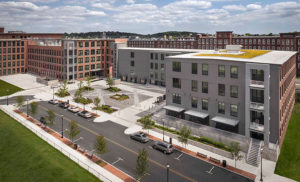
Trinity Financial’s $64 million historic restoration of Lowell's Appleton Mills complex created 130 units of affordable artist housing. Gateway Cities offer opportunities for similar projects in their many downtown Opportunity Zones.
Despite increased state investment, the amount of housing available to low-income renters across Massachusetts has declined in recent years, further squeezing an already-tight market, according to a new report.
There are fewer than half as many affordable homes and apartments as are needed to meet the needs of the state’s poorest residents, a study by the Federal Reserve Bank of Boston’s New England Policy Center concluded. The report, released Wednesday, echoes similar findings last month by the National Low Income Housing Coalition, albeit with some differences in figures.
The report concluded the state will need to build or maintain about 4,000 affordable units every year to keep up with population changes by 2035, an effort that will cost between $843 million and $1 billion annually.
“We are failing those most in need, and we must intentionally take steps to build houses for this population,” MetroHousing|Boston wrote in a statement responding to the report. “Throughout its history, Massachusetts has taken the lead on many initiatives and dedicated state resources to prevent homelessness and support affordable housing. We should therefore not settle for falling behind on the effort to address this emergency or rely on municipalities to do so voluntarily.”
The Massachusetts housing market is notoriously challenging for most residents, but the Fed’s new report focused specifically on households with extremely low income, defined as earning 30 percent or less of their area’s median income. That threshold ranges by geography, falling between $20,000 per year and $30,000 per year for a family of four.
In 2011, there were 50.2 affordable and available units for every 100 families in the extremely low income category, according to the report. By 2016, that rate had declined to 48.6 per 100 families, leaving less than one home within reach for every two households in the deepest poverty.
Over that five-year span, the total number of extremely low income households increased, but the number of rental homes and apartments considered available and affordable for them decreased, growing the shortage to more than 141,000 units.
By 2050, the report found, more than 50,000 affordable units are set to have all of their subsidies expire. If those are not renewed, owners would be free to increase rents, leaving even fewer options for poor residents.
“Once those units are lost, affordable housing is lost with it,” Nicholas Chiumenti, the report’s author, said at the Wednesday panel. “Where this affordability supply for [extremely low income] households goes in the future depends in large part on how we preserve units that are there.”
State officials, who have already made housing production a legislative focus, could opt to ramp up investment in public housing, rental voucher programs or other subsidies. Several panelists pointed out, though, that the federal government plays a much larger role in funding affordable housing.
While the “simple answer” to the crunch in Massachusetts is to invest more money, in the words of Boston Housing Authority administrator Bill McGonagle, that solution is less likely in the wake of significant cuts to public-housing programs the Trump administration proposed in its budget.
“You don’t cut yourself out of a budget like that,” McGonagle said. “You turn the lights off and you go home.”




 |
| 

